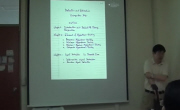With the activation of information search, ubiquitous computing, e-commerce, internet banking, etc., entities such as the government, corporations and individuals are becoming increasingly dependent on information and information systems. Taking advan...
http://chineseinput.net/에서 pinyin(병음)방식으로 중국어를 변환할 수 있습니다.
변환된 중국어를 복사하여 사용하시면 됩니다.
- 中文 을 입력하시려면 zhongwen을 입력하시고 space를누르시면됩니다.
- 北京 을 입력하시려면 beijing을 입력하시고 space를 누르시면 됩니다.
기업의 정보보호수준 자가진단 방법론 연구 및 도구 구현 = Self-assessment Methodology and Implementation of a Self-assessment Tool for Corporation Information Security Level
한글로보기https://www.riss.kr/link?id=T11361298
- 저자
-
발행사항
대전 : 대전대학교 일반대학원, 2008
-
학위논문사항
학위논문(석사) -- 대전대학교 일반대학원 , 컴퓨터공학과 시스템소프트웨어전공 , 2008. 2
-
발행연도
2008
-
작성언어
한국어
- 주제어
-
발행국(도시)
대전
-
형태사항
iv, 81 ; 26cm
-
일반주기명
지도교수 :박진섭
- 소장기관
-
0
상세조회 -
0
다운로드
부가정보
다국어 초록 (Multilingual Abstract)

In order to protect information and information systems from various types of threats, research is being made in the governmental dimension on product evaluation and certification for security systems, information security policies, the improvement of systems, etc. Current methodologies for raising the information security level are under development in consideration of the evaluation of various aspects.
As an effort to enhance the corporate information security level, the present study examined information security level self-assessment methodologies, and designed and implemented a self-assessment tool. Weighting factor was calculated according to the characteristics of corporate business and the importance of security policy factors such as confidentiality, integrity and availability in the area of information security level control.
Through this study on information security level assessment methodologies, we can reduce errors from evaluators' subjective opinions and provide useful materials for corporations' establishment of information security measures. In addition, the implementation of a self-assessment tool will enable evaluation with fewer personnel, and save cost and time.
With the activation of information search, ubiquitous computing, e-commerce, internet banking, etc., entities such as the government, corporations and individuals are becoming increasingly dependent on information and information systems. Taking advantage of this trend, various types of threats including worms/viruses and hacking are increasing through the vulnerability of information and information systems.
In order to protect information and information systems from various types of threats, research is being made in the governmental dimension on product evaluation and certification for security systems, information security policies, the improvement of systems, etc. Current methodologies for raising the information security level are under development in consideration of the evaluation of various aspects.
As an effort to enhance the corporate information security level, the present study examined information security level self-assessment methodologies, and designed and implemented a self-assessment tool. Weighting factor was calculated according to the characteristics of corporate business and the importance of security policy factors such as confidentiality, integrity and availability in the area of information security level control.
Through this study on information security level assessment methodologies, we can reduce errors from evaluators' subjective opinions and provide useful materials for corporations' establishment of information security measures. In addition, the implementation of a self-assessment tool will enable evaluation with fewer personnel, and save cost and time.
목차 (Table of Contents)
- 제1장 서론 = 1
- 1.1 연구의 배경 = 1
- 1.2 연구의 내용 및 범위 = 3
- 1.3 논문의 구성 = 4
- 제2장 관련 연구 = 5
- 제1장 서론 = 1
- 1.1 연구의 배경 = 1
- 1.2 연구의 내용 및 범위 = 3
- 1.3 논문의 구성 = 4
- 제2장 관련 연구 = 5
- 2.1 기업의 정보보호 환경 현황 = 5
- 2.1.1 관리적 현황 = 7
- 2.1.2 기술적 현황 = 10
- 2.1.3 물리적 현황 = 12
- 2.1.4 침해사고 피해 현황 = 14
- 2.2 국외 정보보호수준 평가 사례 = 16
- 2.2.1 연방정보보안관리법 = 16
- 2.2.2 eScan Security Assessment = 20
- 2.2.3 ISG = 22
- 2.2.4 벤치마크 = 24
- 2.3 국내 정보보호수준평가 사례 = 26
- 2.3.1 보안관리수준평가 = 26
- 2.3.2 정보보호수준 평가 = 30
- 2.3.3 중소기업의 자가 측정 도구 = 33
- 2.4 국내·외 정보보호수준 평가 사례 비교 = 35
- 제3장 기업의 정보보호수준 자가진단 방법론 연구 = 36
- 3.1 개요 = 36
- 3.2 기업의 정보보호수준 자가진단 방법론 = 43
- 3.2.1 정보보호수준 자가진단 평가 항목 = 43
- 3.3 기업의 정보보호수준 자가진단 평가 방법 = 49
- 제4장 기업의 정보보호수준 자가진단 도구 설계 및 구현 = 54
- 4.1 정보보호수준 자가진단 도구 설계 = 54
- 4.1.1 자가진단 도구 구조 = 54
- 4.1.2 모듈별 수행 기능 = 55
- 4.2 정보보호수준 자가진단 도구 구현 = 57
- 4.2.1 로그인 모듈 = 57
- 4.2.2 평가자관리 모듈 = 59
- 4.2.3 가중치 평가 모듈 = 60
- 4.2.4 정보보호수준 평가 모듈 = 62
- 4.2.5 평가 결과 모듈 = 64
- 제5장 자가진단 도구 구현결과 및 분석 = 66
- 5.1 정보보호수준 자가진단 결과 = 66
- 5.1.1 시나리오 = 66
- 5.1.2 정보보호수준 자가진단 결과 = 67
- 5.2 정보보호수준 자가진단 방법론 효과성 분석 = 68
- 5.2.1 기존의 방법론과 비교 = 69
- 5.2.2 다른 방법론과 비교 = 70
- 제6장 결론 = 71
- 참고문헌 = 73
- Abstract = 75












